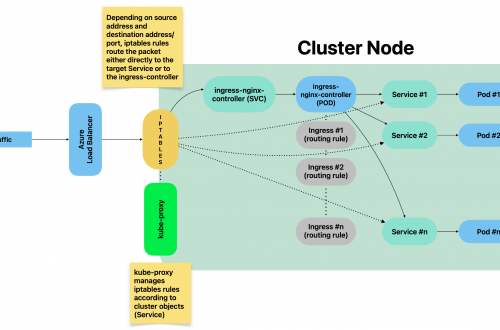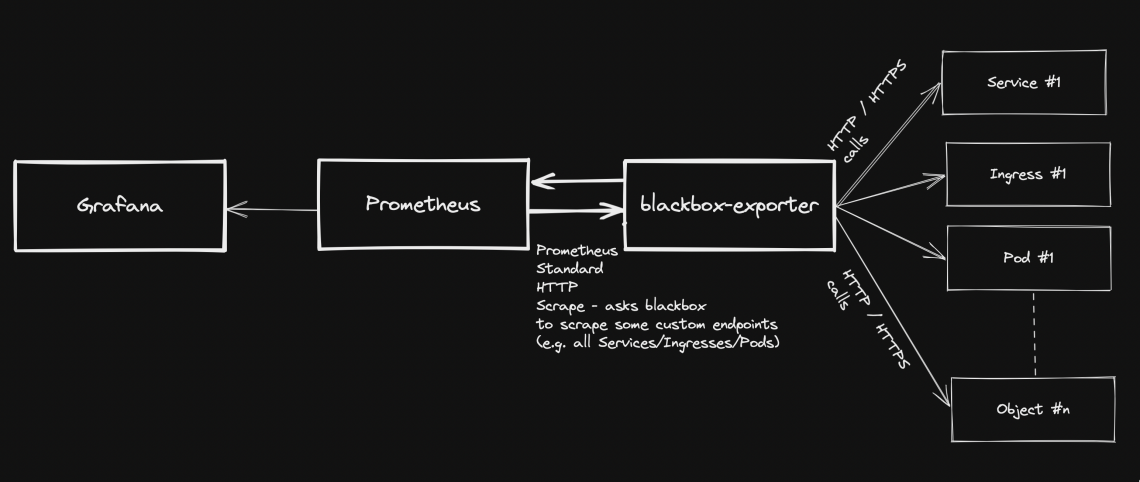Monitoring Tools
-
How to expose kubernetes api-server metrics
Kubernetes api-server provides very interesting metrics which could make a difference when it comes to detecting potential security threats.
Accessing api-server requires a Token and a certificate. Both must be related to a ServiceAccount with sufficient permissions to access metrics endpoint. This post describes how to achieve such setup.
Namespace
Before to start, make sure your current context is using “default” namespacekubectl config set-context --current --namespace=default
Step 1: Create a new ServiceAccount
kubectl create serviceaccount metrics-explorer
Step 2: Create a new ClusterRole with sufficient permissions to access api-server metrics endpoint via HTTP GET
kind: ClusterRole apiVersion: rbac.authorization.k8s.io/v1 metadata: name: metrics-explorer rules: - nonResourceURLs: - /metrics - /metrics/cadvisor verbs: - get
Step 3: Create new ClusterRoleBinding to bind the ServiceAccount with ClusterRole
kubectl create clusterrolebinding metrics-explorer:metrics-explorer --clusterrole metrics-explorer --serviceaccount default:metrics-explorer
Step 4: Export ServiceAccount’s token Secret’s name
SERVICE_ACCOUNT=metrics-explorer SECRET=$(kubectl get serviceaccount ${SERVICE_ACCOUNT} -o json | jq -Mr '.secrets[].name | select(contains("token"))')Step 5: Extract Bearer token from Secret and decode it
TOKEN=$(kubectl get secret ${SECRET} -o json | jq -Mr '.data.token' | base64 -d)Step 6: Extract, decode and write the ca.crt to a temporary location
kubectl get secret ${SECRET} -o json | jq -Mr '.data["ca.crt"]' | base64 -d > /tmp/ca.crtFinal step: Test access to metrics endpoint
curl -s <API-SERVER>/metrics --header "Authorization: Bearer $TOKEN" --cacert /tmp/ca.crt | less
Configuring as additional scrape target on Prometheus
Transfer the certificate file from api-server’s VM to Prometheus’ VM. (e.g. destination filename: /opt/api-server-files/ca.crt)
Save the TOKEN obtained on steps above to a file on Prometheus’ VM. (e.g. destination filename: /opt/api-server-files/api-server-token)
Edit Prometheus main configuration file (e.g. /etc/prometheus/prometheus.yml) and add the following scrape target:
- bearer_token_file: /opt/api-server-files/api-server-token job_name: kubernetes-apiservers static_configs: - targets: ['<API-SERVER-IP>:6443'] metrics_path: '/metrics' scheme: https tls_config: ca_file: /opt/api-server-files/ca.crt -
Kubernetes observability – log aggregation – Grafana-loki deployment and configuration
Table of Contents
Intro
This page describes how to deploy and apply basic configurations – including retention policies – to a promtail-loki stack.
Loki is a log storage solution tightly integrated with Grafana. It can ingest logs from multiple sources (in our case, containers), index them and makes them accessible via Grafana UI.
Its functionalities overlap with elasticsearch. Grafana-loki is more lightweight since it indexes only entries metadata and not the entire content of each log line.
Data can be pushed into loki with multiple solutions (e.g. promtail, fluent bit, fluentd, logstash, etc.). See https://grafana.com/docs/loki/latest/clients/
This page describes how to use promtail for such purpose.
The following setup is not meant to be used on production environments.
Requirements
- A k8s cluster including Grafana
- all appropriate configurations to use kubectl command line tool
Loki deployment
- Add loki helm chart repo
helm repo add grafana https://grafana.github.io/helm-charts helm repo update
- Create a file values.yaml to store all chart settings that must be overridden from the default values
loki: commonConfig: replication_factor: 1 storage: type: 'filesystem' compactor: working_directory: /var/loki/data/retention shared_store: filesystem compaction_interval: 10m retention_enabled: true retention_delete_delay: 2h retention_delete_worker_count: 150 schema_config: configs: - from: "2022-12-01" index: period: 24h prefix: loki_index_ object_store: filesystem schema: v11 store: boltdb-shipper storage_config: boltdb_shipper: active_index_directory: /var/loki/data/index cache_location: /var/loki/data/boltdb-cache shared_store: filesystem limits_config: retention_period: 24h write: replicas: 1 read: replicas: 1- Create the namespace
kubectl create namespace loki
- Create 2 PersistentVolumes that will be used by loki read / write components
apiVersion: v1 kind: PersistentVolume metadata: name: loki-pv-1 namespace: loki spec: accessModes: - ReadWriteOnce capacity: storage: 10Gi persistentVolumeReclaimPolicy: Retain local: path: [YOUR_NODE_LOCAL_STORAGE_FOLDER_1] nodeAffinity: required: nodeSelectorTerms: - matchExpressions: - key: kubernetes.io/hostname operator: In values: - [YOUR_NODE_NAME] --- apiVersion: v1 kind: PersistentVolume metadata: name: loki-pv-2 namespace: loki spec: accessModes: - ReadWriteOnce capacity: storage: 10Gi persistentVolumeReclaimPolicy: Retain local: path: [YOUR_NODE_LOCAL_STORAGE_FOLDER_2] nodeAffinity: required: nodeSelectorTerms: - matchExpressions: - key: kubernetes.io/hostname operator: In values: - [YOUR_NODE_NAME]- Install the helm chart
helm install --values values.yaml loki --namespace=loki grafana/loki-simple-scalable
Once all components are started up, you should have the following scenario:
[rockylinux@test-vm grafana-loki]$ kubectl get all -n loki NAME READY STATUS RESTARTS AGE pod/loki-gateway-55fccf8654-vcxqt 1/1 Running 0 23h pod/loki-grafana-agent-operator-684b478b77-vwh9g 1/1 Running 0 23h pod/loki-logs-wwcp5 2/2 Running 0 23h pod/loki-read-0 1/1 Running 0 32m pod/loki-write-0 1/1 Running 0 32m NAME TYPE CLUSTER-IP EXTERNAL-IP PORT(S) AGE service/loki-gateway ClusterIP 10.106.191.67 <none> 80/TCP 23h service/loki-memberlist ClusterIP None <none> 7946/TCP 23h service/loki-read ClusterIP 10.103.120.150 <none> 3100/TCP,9095/TCP 23h service/loki-read-headless ClusterIP None <none> 3100/TCP,9095/TCP 23h service/loki-write ClusterIP 10.98.226.44 <none> 3100/TCP,9095/TCP 23h service/loki-write-headless ClusterIP None <none> 3100/TCP,9095/TCP 23h NAME DESIRED CURRENT READY UP-TO-DATE AVAILABLE NODE SELECTOR AGE daemonset.apps/loki-logs 1 1 1 1 1 <none> 23h NAME READY UP-TO-DATE AVAILABLE AGE deployment.apps/loki-gateway 1/1 1 1 23h deployment.apps/loki-grafana-agent-operator 1/1 1 1 23h NAME DESIRED CURRENT READY AGE replicaset.apps/loki-gateway-55fccf8654 1 1 1 23h replicaset.apps/loki-grafana-agent-operator-684b478b77 1 1 1 23h NAME READY AGE statefulset.apps/loki-read 1/1 23h statefulset.apps/loki-write 1/1 23h
Promtail deployment
Promtail tails log files and pushed them into loki.
To deploy all required components, apply the following yaml:
--- # Daemonset.yaml apiVersion: apps/v1 kind: DaemonSet metadata: name: promtail-daemonset spec: selector: matchLabels: name: promtail template: metadata: labels: name: promtail spec: serviceAccount: promtail-serviceaccount containers: - name: promtail-container image: grafana/promtail args: - -config.file=/etc/promtail/promtail.yaml env: - name: 'HOSTNAME' # needed when using kubernetes_sd_configs valueFrom: fieldRef: fieldPath: 'spec.nodeName' volumeMounts: - name: logs mountPath: /var/log - name: promtail-config mountPath: /etc/promtail - mountPath: /var/lib/docker/containers name: varlibdockercontainers readOnly: true volumes: - name: logs hostPath: path: /var/log - name: varlibdockercontainers hostPath: path: /var/lib/docker/containers - name: promtail-config configMap: name: promtail-config --- # Daemonset.yaml apiVersion: apps/v1 kind: DaemonSet metadata: name: promtail-daemonset spec: selector: matchLabels: name: promtail template: metadata: labels: name: promtail spec: serviceAccount: promtail-serviceaccount containers: - name: promtail-container image: grafana/promtail args: - -config.file=/etc/promtail/promtail.yaml env: - name: 'HOSTNAME' # needed when using kubernetes_sd_configs valueFrom: fieldRef: fieldPath: 'spec.nodeName' volumeMounts: - name: logs mountPath: /var/log - name: promtail-config mountPath: /etc/promtail - mountPath: /var/lib/docker/containers name: varlibdockercontainers readOnly: true volumes: - name: logs hostPath: path: /var/log - name: varlibdockercontainers hostPath: path: /var/lib/docker/containers - name: promtail-config configMap: name: promtail-config -- # configmap.yaml apiVersion: v1 kind: ConfigMap metadata: name: promtail-config data: promtail.yaml: | server: http_listen_port: 9080 grpc_listen_port: 0 clients: - url: http://loki-write.loki.svc.cluster.local:3100/loki/api/v1/push tenant_id: 1 positions: filename: /tmp/positions.yaml target_config: sync_period: 10s scrape_configs: - job_name: pod-logs kubernetes_sd_configs: - role: pod pipeline_stages: - docker: {} relabel_configs: - source_labels: - __meta_kubernetes_pod_node_name target_label: __host__ - action: labelmap regex: __meta_kubernetes_pod_label_(.+) - action: replace replacement: $1 separator: / source_labels: - __meta_kubernetes_namespace - __meta_kubernetes_pod_name target_label: job --- # Daemonset.yaml apiVersion: apps/v1 kind: DaemonSet metadata: name: promtail-daemonset spec: selector: matchLabels: name: promtail template: metadata: labels: name: promtail spec: serviceAccount: promtail-serviceaccount containers: - name: promtail-container image: grafana/promtail args: - -config.file=/etc/promtail/promtail.yaml env: - name: 'HOSTNAME' # needed when using kubernetes_sd_configs valueFrom: fieldRef: fieldPath: 'spec.nodeName' volumeMounts: - name: logs mountPath: /var/log - name: promtail-config mountPath: /etc/promtail - mountPath: /var/lib/docker/containers name: varlibdockercontainers readOnly: true volumes: - name: logs hostPath: path: /var/log - name: varlibdockercontainers hostPath: path: /var/lib/docker/containers - name: promtail-config configMap: name: promtail-config -- # configmap.yaml apiVersion: v1 kind: ConfigMap metadata: name: promtail-config data: promtail.yaml: | server: http_listen_port: 9080 grpc_listen_port: 0 clients: - url: http://loki-write.loki.svc.cluster.local:3100/loki/api/v1/push tenant_id: 1 positions: filename: /tmp/positions.yaml target_config: sync_period: 10s scrape_configs: - job_name: pod-logs kubernetes_sd_configs: - role: pod pipeline_stages: - docker: {} relabel_configs: - source_labels: - __meta_kubernetes_pod_node_name target_label: __host__ - action: labelmap regex: __meta_kubernetes_pod_label_(.+) - action: replace replacement: $1 separator: / source_labels: - __meta_kubernetes_namespace - __meta_kubernetes_pod_name target_label: job - action: replace source_labels: - __meta_kubernetes_namespace target_label: namespace - action: replace source_labels: - __meta_kubernetes_pod_name target_label: pod - action: replace source_labels: - __meta_kubernetes_pod_container_name target_label: container - replacement: /var/log/pods/*$1/*.log separator: / source_labels: - __meta_kubernetes_pod_uid - __meta_kubernetes_pod_container_name target_label: __path__ --- # Clusterrole.yaml apiVersion: rbac.authorization.k8s.io/v1 kind: ClusterRole metadata: name: promtail-clusterrole rules: - apiGroups: [""] resources: - nodes - services - pods verbs: - get - watch - list --- # ServiceAccount.yaml apiVersion: v1 kind: ServiceAccount metadata: name: promtail-serviceaccount --- # Rolebinding.yaml apiVersion: rbac.authorization.k8s.io/v1 kind: ClusterRoleBinding metadata: name: promtail-clusterrolebinding subjects: - kind: ServiceAccount name: promtail-serviceaccount namespace: default roleRef: kind: ClusterRole name: promtail-clusterrole apiGroup: rbac.authorization.k8s.ioLoki datasource configuration on Grafana admin UI
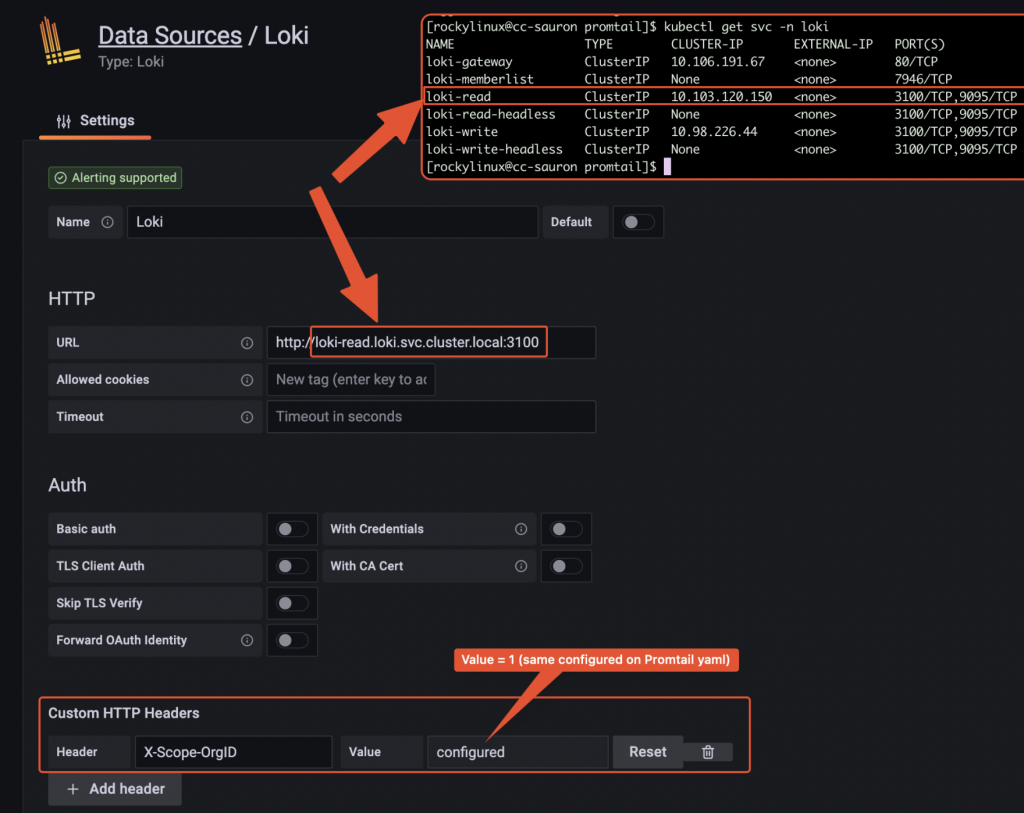
Datasource configuration on Grafana Browsing logs from Grafana UI
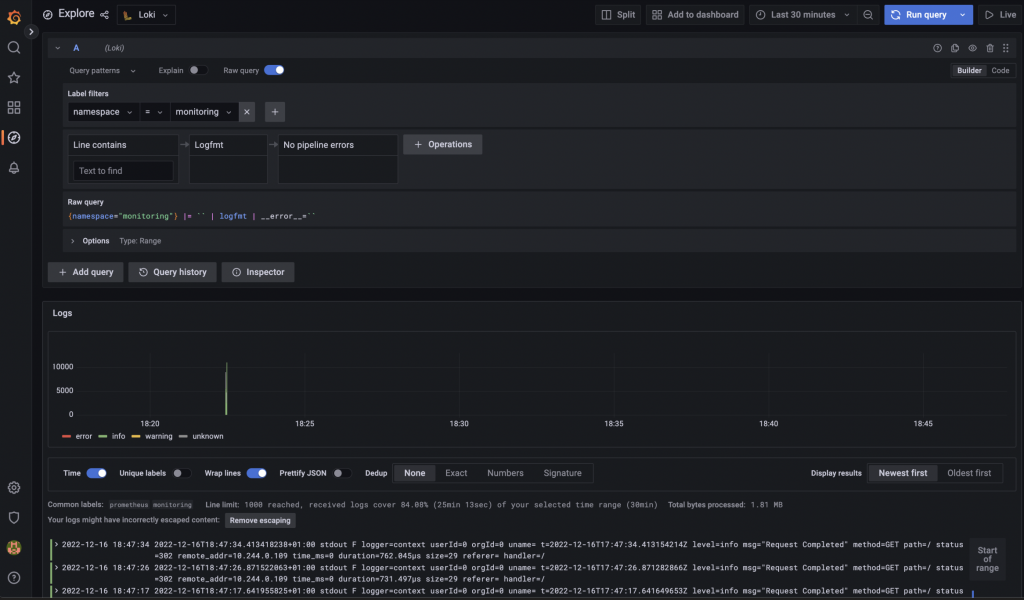
Data browser on Grafana -
Kubernetes security: Detect and react to intrusions with Falco
Table of Contents
Intro
Falco is an open-source application that you can use to detect (and, optionally, react) intrusions.
It comes with a set of pre-installed rules to which exceptions can be easily added.
Custom rules can of course be installed as well.
Events can be fetched both interacting with a kernel module, eBPF probes are also supported.
This guide covers first use-case above and relates to deployment via helm chart within a kubernetes cluster.
Installation
Pre-requisites
This guide assumes you have a pre-installed kubernetes cluster (on-premise) with all necessary configurations to use kubectl.
Debian / Ubuntu based OS
Install packages required to fetch syscall from host OS kernel:
curl -s https://falco.org/repo/falcosecurity-3672BA8F.asc | apt-key add - echo "deb https://download.falco.org/packages/deb stable main" | tee -a /etc/apt/sources.list.d/falcosecurity.list apt-get update -y apt-get -y install linux-headers-$(uname -r)
CentOS/RHEL/Fedora/Amazon Linux based OS
rpm --import https://falco.org/repo/falcosecurity-3672BA8F.asc curl -s -o /etc/yum.repos.d/falcosecurity.repo https://falco.org/repo/falcosecurity-rpm.repo yum -y install kernel-devel-$(uname -r)
Installing via helm chart
helm repo add falcosecurity https://falcosecurity.github.io/charts helm repo update
Now, create the namespace:
kubectl create namespace falco
Create a new PersistentVolume. Make sure to replace the following attributes according to your needs/environment:
- spec.capacity.storage
- spec.local.path (pathname of local directory on your host node)
- spec.nodeAffinity.required.nodeSelectorTerms.matchExpressions.key.value (must match your k8s node’s name)
apiVersion: v1 kind: PersistentVolume metadata: annotations: finalizers: - kubernetes.io/pv-protection name: redis-data namespace: falco spec: accessModes: - ReadWriteOnce capacity: storage: 5Gi local: path: YOUR_LOCAL_PATH_HERE nodeAffinity: required: nodeSelectorTerms: - matchExpressions: - key: kubernetes.io/hostname operator: In values: - YOUR_NODE_NAME_HERE persistentVolumeReclaimPolicy: Retain volumeMode: FilesystemInstall the helm chart:
helm install falco \ --set falco.grpc.enabled=true \ --set falco.grpc_output.enabled=true \ --set falcosidekick.enabled=true \ --set falcosidekick.webui.enabled=true \ falcosecurity/falco \ --namespace falco
Make sure all pods are up and running:
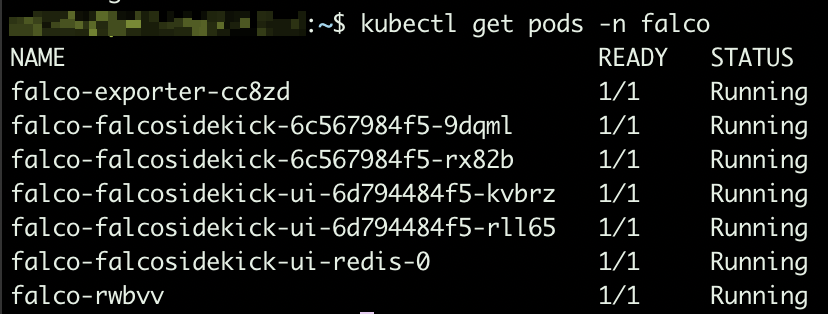
Falco pods Based on the arguments we provided while installing the helm chart, sidekick UI is enabled. To make it accessible, you will have to expose port 2802:
kubectl expose service falco-falcosidekick-ui --port=2802 --target-port=2802 --external-ip=YOUR_NODE_IP_ADDRESS --name=falco-falcosidekick-ui-external -n falco
From this moment, you should be able to access sidekick UI at http://YOUR_NODE_IP_ADDRESS:2802
Default credentials: admin/admin

Falco sidekick UI Adding rules exceptions
You might need to add exceptions to pre-installed rules since they might be too restrictive based on how you use this system.
To do so, create a yaml file (e.g. rules_exceptions.yaml) and add your exceptions.
Sample:
customRules: custom_rules_from_default: |- - rule: Read sensitive file untrusted append: true exceptions: - name: microsoft_omsagent_plugin fields: [container.id, fd.name, proc.cmdline, proc.name, proc.pname, user.name] comps: [=, =, =, =, =, =] values: - [host, /etc/shadow, omsbaseline -d /opt/microsoft/omsagent/plugin/, omsbaseline, omsbaseline, root] - name: wdavdaemon fields: [proc.name] comps: [=] values: - [wdavdaemon]2nd rule above (name: wdavdaemon) will not fire any alert in case default settings for rule “wdavdaemon” are satisfied but the syscall attribute proc.name = “wdavdaemon”.
1st rule above is providing an exception based on value from multiple attributes (container.id, fd.name, etc.)
To install the new rule file, upgrade the helm chart:
helm upgrade --install falco falcosecurity/falco --namespace falco --reuse-values -f rules_exceptions.yaml
Whenever an event breaks a security rule, it gets logged to stdout.
Exporting events to Prometheus
stdout from falco core can be made available as application metric so that Prometheus can easily scrape such endpoint and have access to all events.
To do so, we need to deploy an extra component: Falco exporter (see https://github.com/falcosecurity/falco-exporter)
This component can be easily installed via helm chart:
helm install falco-exporter falcosecurity/falco-exporter --namespace falco
Falco-exporter is available, by default, on port 9376. In case your Prometheus instance is running on a different host, you will have to expose the port:
helm install falco-exporter falcosecurity/falco-exporter --namespace falco kubectl expose service falco-exporter --port=9376 --target-port=9376 --external-ip=YOUR_NODE_IP_HERE --name=falco-exporter-external -n falco
From this moment, you can add http://YOUR_NODE_IP:9376 as additional scrape target to your Prometheus configuration.
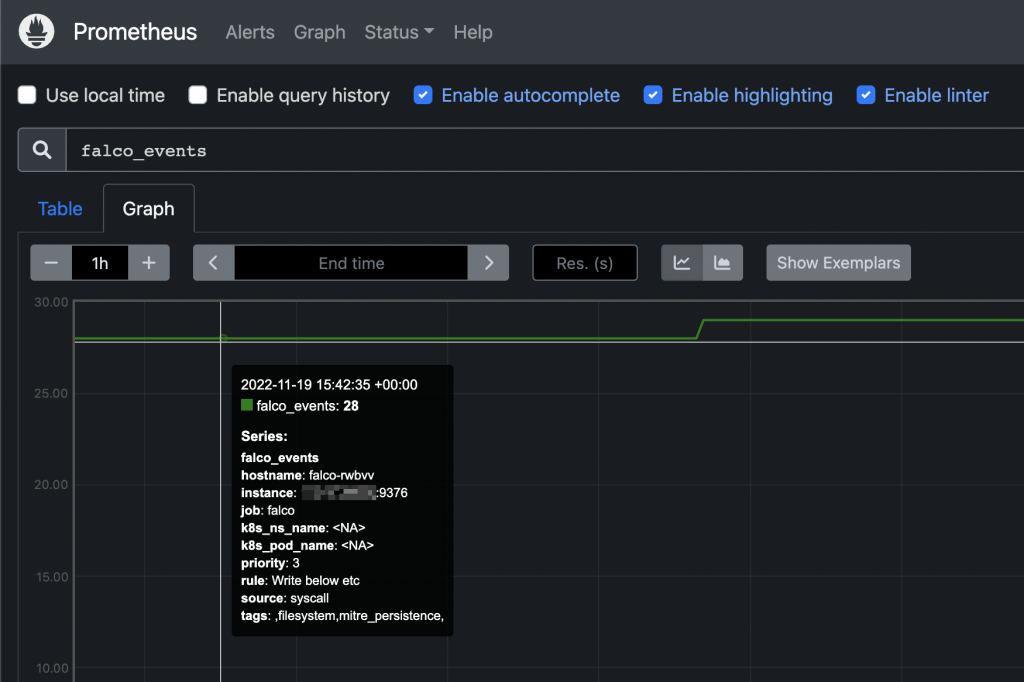
Falco events on Prometheus UI From this moment you can add custom alerts on Prometheus or, even better, create your owns from Grafana’s UI.
Adding custom alerts to Prometheus How to send email notifications from Grafana alerts -
Monitoring application health with blackbox-exporter
Prometheus standard deployment and configuration has already been discussed on other posts, but what if you want to expose metrics about your custom application stack health? This page explains how to achieve this, by taking advantage of blackbox-exporter, so that your application components running on a kubernetes cluster will be easily monitored.
Intro
Generally speaking, blackbox stands in between your Prometheus instance and your custom application components: Prometheus fetches metrics asking blackbox to target custom endpoints. Response will be given back using the format expected by Prometheus. Endspoints are typically your cluster’s Pods, Services and Ingresses.
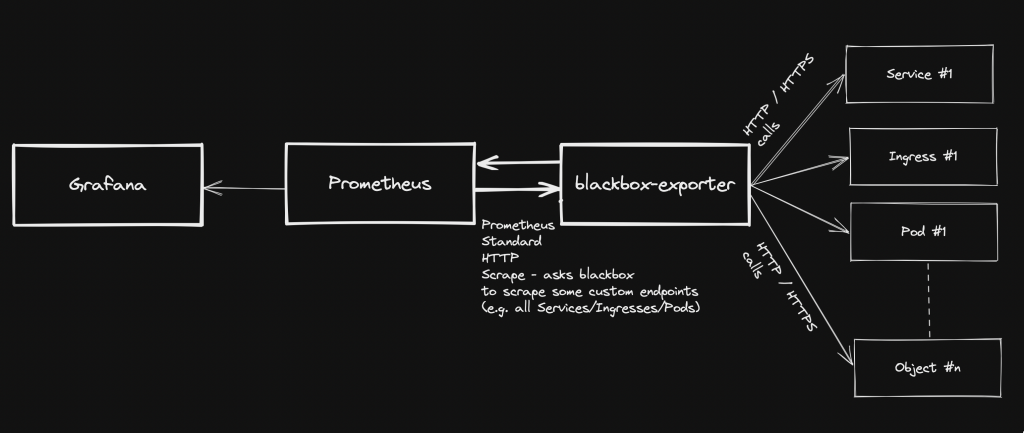
Overview Pre-requirements
- A kubernetes cluster with kubectl configured to interact with it
- Prometheus-operator stack – see https://github.com/prometheus-operator/prometheus-operator
- Grafana (part of Prometheus-operator)
blackbox-exporter installation (via helm chart)
- Add the helm repo
helm repo add prometheus-community https://prometheus-community.github.io/helm-charts help repo update
- Create a file: values.yaml
config: modules: http_2xx: prober: http timeout: 5s http: valid_http_versions: ["HTTP/1.1", "HTTP/2.0"] follow_redirects: true preferred_ip_protocol: "ip4"- Install the helm chart (in this case, we are using “monitoring” namespace):
helm install prometheus-blackbox prometheus-community/prometheus-blackbox-exporter -n monitoring -f values.yaml
Adding custom scrape targets to blackbox
As regards how to add extra scrape targets, see https://matteorenzi.com/2022/10/08/prometheus-operator-how-to-add-custom-scrape-targets/
Below some sample targets that you might want to add:
Probing external targets (sample: www.google.com)
- job_name: 'blackbox-external-targets' metrics_path: /probe params: module: [http_2xx] static_configs: - targets: - https://www.google.com relabel_configs: - source_labels: [__address__] target_label: __param_target - source_labels: [__param_target] target_label: instance - target_label: __address__ replacement: prometheus-blackbox-prometheus-blackbox-exporter.monitoring.svc.cluster.local:9115Probing your cluster Services
- job_name: "blackbox-kubernetes-services" metrics_path: /probe params: module: [http_2xx] kubernetes_sd_configs: - role: service relabel_configs: - source_labels: [__address__] target_label: __param_target - target_label: __address__ replacement: prometheus-blackbox-prometheus-blackbox-exporter.monitoring.svc.cluster.local:9115 - source_labels: [__param_target] target_label: instance - action: labelmap regex: __meta_kubernetes_service_label_(.+) - source_labels: [__meta_kubernetes_namespace] target_label: kubernetes_namespace - source_labels: [__meta_kubernetes_service_name] target_label: kubernetes_service_nameProbing cluster Ingresses
- job_name: "blackbox-kubernetes-ingresses" metrics_path: /probe params: module: [http_2xx] kubernetes_sd_configs: - role: ingress relabel_configs: - source_labels: [ __meta_kubernetes_ingress_scheme, __address__, __meta_kubernetes_ingress_path, ] regex: (.+);(.+);(.+) replacement: :// target_label: __param_target - target_label: __address__ replacement: prometheus-blackbox-prometheus-blackbox-exporter.monitoring.svc.cluster.local:9115 - source_labels: [__param_target] target_label: instance - action: labelmap regex: __meta_kubernetes_ingress_label_(.+) - source_labels: [__meta_kubernetes_namespace] target_label: kubernetes_namespace - source_labels: [__meta_kubernetes_ingress_name] target_label: ingress_nameProbing cluster Pods
- job_name: "blackbox-kubernetes-pods" metrics_path: /probe params: module: [http_2xx] kubernetes_sd_configs: - role: pod relabel_configs: - source_labels: [__address__] target_label: __param_target - target_label: __address__ replacement: prometheus-blackbox-prometheus-blackbox-exporter.monitoring.svc.cluster.local:9115 - source_labels: [__param_target] replacement: /health target_label: instance - action: labelmap regex: __meta_kubernetes_pod_label_(.+) - source_labels: [__meta_kubernetes_namespace] target_label: kubernetes_namespace - source_labels: [__meta_kubernetes_pod_name] target_label: kubernetes_pod_nameChecking new targets / probes
Once the new scraping targets have been applied, they must be visible on Prometheus: Status -> Targets
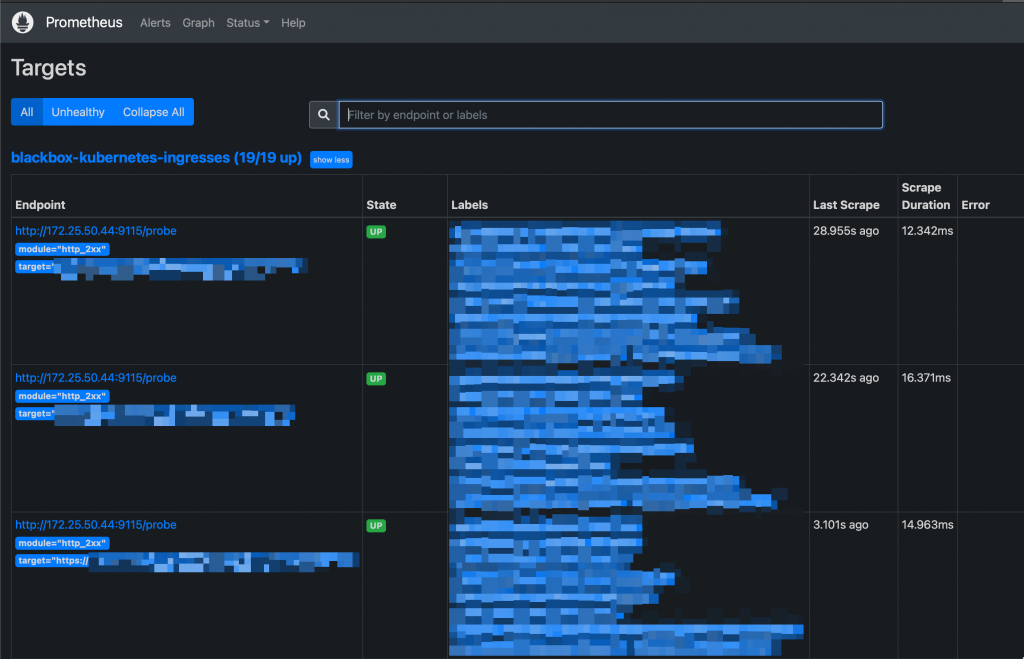
New Targets on Prometheus UI Probes can be queried like this:
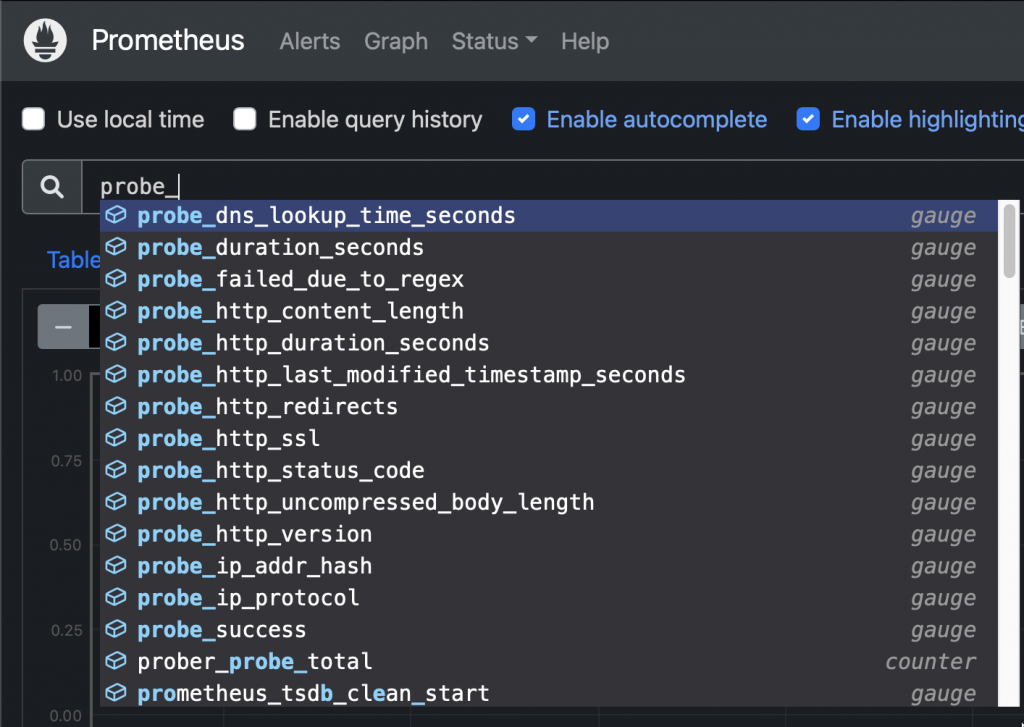
New probes Sample query: Check HTTP status code from an ingress:
probe_http_status_code{ingress_name="xxxxx"}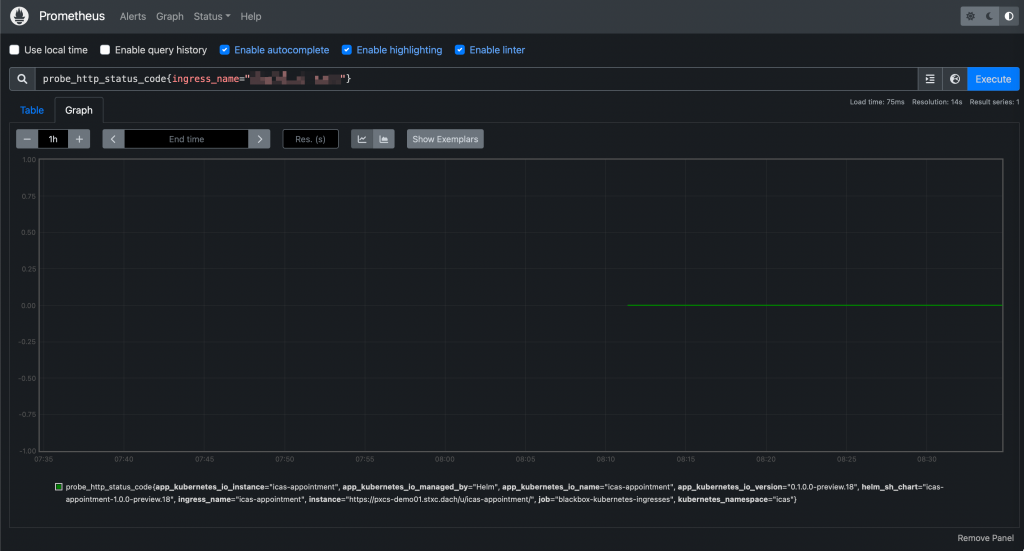
Prometheus UI: Querying a probe And they will be accessible from Grafana as well:
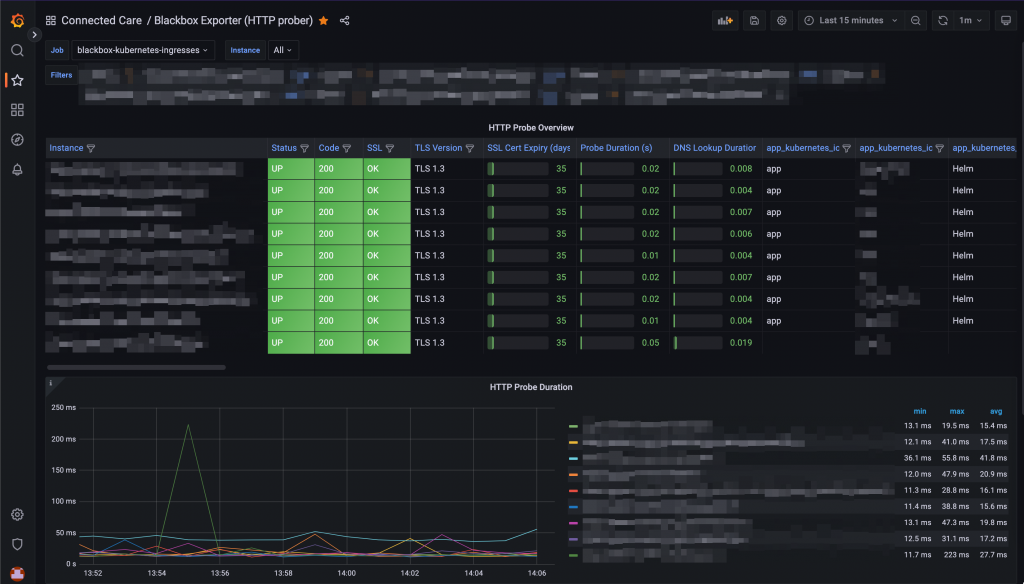
Probes visualisation on a Grafana dashboard -
Grafana running on kubernetes: How to configure SMTP integration
Grafana has a built-in alerting system and it can be used to trigger email notifications whenever an alert is raised. This page shows you how to configure the integration with an external SMTP server.
- Create a ConfigMap that includes the grafana.ini main configuration file
- Sample ConfigMap yaml manifest:
apiVersion: v1 data: grafana.ini: | [analytics] check_for_updates = true [grafana_net] url = https://grafana.net [log] mode = console [paths] data = /var/lib/grafana/ logs = /var/log/grafana plugins = /var/lib/grafana/plugins provisioning = /etc/grafana/provisioning [server] domain = [smtp] enabled = true host = smtp.test.com:587 user = test@test.com password = xxxxxxxxx startTLS_policy = MandatoryStartTLS skip_verify = true from_address = test@test.com from_name = Grafana kind: ConfigMap metadata: annotations: meta.helm.sh/release-name: prometheus meta.helm.sh/release-namespace: monitoring labels: app.kubernetes.io/instance: prometheus app.kubernetes.io/managed-by: Helm app.kubernetes.io/name: grafana app.kubernetes.io/version: 9.1.4 helm.sh/chart: grafana-6.38.0 name: prometheus-grafana namespace: monitoring- Restart grafana pod(s) to apply the new config described above:
# kubectl delete -n monitoring $(kubectl get pods -n monitoring -o=name -l app.kubernetes.io/name=grafana)
- Create a ConfigMap that includes the grafana.ini main configuration file







